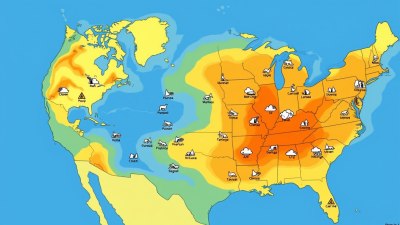Why Weather Keeps Changing Like It’s Trying to Win an Oscar
Explore the reasons behind the unpredictable nature of weather and climate change impacts.

This image was created with the assistance of Freepik
The weather is often likened to a dramatic actor, with its ability to shift and change, keeping everyone on their toes. Just like an Oscar-winning performance captures the audience's attention, so too does the dynamic and often unpredictable nature of our atmosphere. This constant variability can leave many people wondering why weather changes so frequently. The fluctuation in weather patterns, from sunny skies to thunderstorms, reflects a complex interplay of various factors at work. In this article, we will explore the key concepts behind these shifts in weather, the influence of climate change, and how they all tie back to the intricate system that governs our planet.
The Basics of Weather
At its core, weather refers to the short-term atmospheric conditions in a particular area at a specific time. It encompasses elements like temperature, humidity, precipitation, wind speed, and atmospheric pressure. Weather changes from hour to hour, day to day, based on a variety of factors, including geographical location, seasonal variations, and even the time of day.
In contrast, climate represents the long-term average of weather conditions over an extended period, typically defined by 30 years of data. While weather is what you experience on a daily basis, climate reflects the broader picture of atmospheric patterns and trends. Understanding the distinction between weather and climate is crucial in grasping why weather seems to change so dramatically.
Influencing Factors
Several natural phenomena contribute to weather variability. One of the most significant factors is the sun’s energy. The uneven heating of the Earth's surface by the sun creates temperature gradients that drive atmospheric circulation. Warm air rises, while cool air sinks, creating wind patterns that influence local weather. Additionally, geographical features such as mountains and bodies of water play a vital role in weather dynamics. They can create microclimates and localized weather patterns, often leading to sudden changes.
Another important factor is the presence of weather systems. High-pressure systems are typically associated with clear skies and calm weather, while low-pressure systems can lead to cloudiness and precipitation. The movement and interaction of these systems can result in rapidly changing weather conditions. For instance, a cold front moving in from the north can bring sudden temperature drops and storms, while a warm front can lead to milder conditions.
The Role of Climate Change
In recent years, climate change has become an increasingly important factor shaping weather patterns. As global temperatures rise due to greenhouse gas emissions, we are witnessing changes in precipitation patterns, increased frequency and intensity of extreme weather events, and shifts in seasonal weather patterns. Scientists predict that as the planet continues to warm, we will experience more unpredictable weather as the atmosphere reaches new levels of instability.
Research indicates that climate change increases the likelihood of heatwaves, heavy rainfall, and hurricanes. The warmer atmosphere holds more moisture, leading to heavier downpours and an increased risk of flooding. Additionally, warmer ocean temperatures can fuel stronger storms, contributing to weather unpredictability. As a result, extreme weather occurrences that were once rare are now becoming more common, leading to a greater perception of erratic weather.
Seasonal Changes and Their Impact
The transition between seasons also plays a significant role in weather variability. During spring and fall, the interaction between warm and cold air masses can lead to rapidly changing weather. For example, a warm day in early spring can quickly shift to a cold, rainy afternoon as cold fronts move in. Similarly, autumn can see a swift change from mild temperatures to chilly conditions as winter approaches.
Seasonal changes are influenced by the tilt of the Earth's axis and its orbit around the sun, leading to variations in daylight hours and solar radiation. These natural cycles can lead to fluctuations in temperature and precipitation, as well as the appearance of storms as different air masses collide. As we progress through the seasons, the weather can often feel as though it is in a dramatic tumult, with each day bringing a new surprise.
The Impact of Urbanization
Urbanization has also added another layer of complexity to local weather patterns. Cities are often warmer than surrounding rural areas, a phenomenon known as the urban heat island effect. Urban surfaces, such as asphalt and concrete, absorb and retain heat more effectively than natural landscapes. This can lead to localized climatic changes and influence local weather conditions.
Additionally, the concentration of buildings, vehicles, and human activities in urban areas can alter wind patterns and humidity levels. The presence of these heat islands can create conditions that lead to increased rainfall and storm initiation. As more people move into cities, the interplay between urbanization and weather continues to evolve and complicate the already intricate patterns of atmospheric change.
Predicting the Unpredictable
With so many variables at play, predicting the weather can be a challenging task. Meteorologists use advanced technology, including satellites and radar systems, to monitor and analyze atmospheric conditions. Weather models simulate various scenarios based on current data, helping forecasters make predictions about upcoming weather events. However, despite significant advancements in meteorological science, the atmosphere’s inherent unpredictability means that forecasts are not always accurate.
For instance, a weather model may forecast a sunny day, while unexpected conditions could arise, leading to overcast skies instead. This unpredictability is similar to an award-winning actor taking unexpected turns in their performance. The more complex the atmospheric conditions, the more difficulty meteorologists may have in providing reliable predictions.
The Psychology of Weather Changes
It’s not just the scientific community that feels the impact of changing weather; it also affects everyday life. As the weather changes, so do our plans, moods, and behaviors. For many, sunny skies can bring feelings of happiness and positivity, while overcast days can sometimes lead to feelings of gloom. The unpredictability of weather can create anxiety and stress, especially when sudden storms threaten plans or outdoor activities.
Moreover, the constant fluctuations in weather can influence public perception and even lead to misunderstandings about climate change. Some may erroneously associate short-term weather fluctuations with long-term climate trends, leading to confusion about the reality of global warming. Understanding that climate change represents long-term impacts rather than day-to-day weather variations is an essential part of navigating our changing world.
Weather is a complex and constantly changing system shaped by a variety of influences, including the sun's energy, geographical features, climate change, and human activity. Our experience of weather variability can feel dramatic, much like an Oscar-winning performance, as every day brings a new twist to the story. By understanding the factors that contribute to weather changes, we can better navigate the unpredictability of our atmospheric environment and perhaps appreciate the unique performance nature has to offer.











